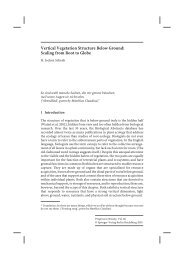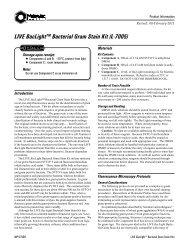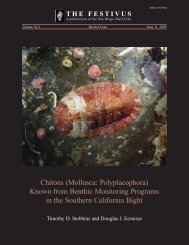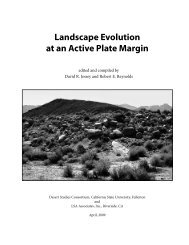2010 Overboard in the Mojave - Biological Science - California State ...
2010 Overboard in the Mojave - Biological Science - California State ...
2010 Overboard in the Mojave - Biological Science - California State ...
Create successful ePaper yourself
Turn your PDF publications into a flip-book with our unique Google optimized e-Paper software.
Environments of nearshore lacustr<strong>in</strong>e<br />
deposition <strong>in</strong> <strong>the</strong> Pleistocene Lake Manix<br />
bas<strong>in</strong>, south-central <strong>California</strong><br />
Marith C. Reheis and David M. Miller<br />
USGS, Menlo Park, CA mreheis@usgs.gov, dmiller@usgs.gov<br />
Abstract<br />
Lake Manix, <strong>in</strong> <strong>the</strong> central <strong>Mojave</strong> Desert of sou<strong>the</strong>rn <strong>California</strong>, was <strong>the</strong> term<strong>in</strong>us<br />
of <strong>the</strong> <strong>Mojave</strong> River from about 500 to 25 ka. Deposits of this lake provide excellent<br />
examples of depositional environments of a low-desert, clastic-dom<strong>in</strong>ated lake<br />
susta<strong>in</strong>ed by a mostly perennial river, a sett<strong>in</strong>g atypical for most Great Bas<strong>in</strong> pluvial<br />
lakes. We characterize and provide examples of <strong>the</strong> nearshore environments of<br />
deposition of Lake Manix, which <strong>in</strong>clude extensive low-gradient fluvial-deltaic and<br />
mudflat deposits and ephemeral alluvial-fan–lake-marg<strong>in</strong>al deposits, to aid <strong>in</strong> <strong>the</strong>ir<br />
recognition <strong>in</strong> o<strong>the</strong>r sett<strong>in</strong>gs and <strong>in</strong> <strong>the</strong> geologic record. The sedimentary character<br />
and stratigraphic architecture of <strong>the</strong>se nearshore deposits depend on proximity to<br />
<strong>the</strong> mouth of <strong>the</strong> <strong>Mojave</strong> River, to position on fr<strong>in</strong>g<strong>in</strong>g alluvial fans, to steepness of<br />
fan slope, and to presence of active channels. Recognition of <strong>the</strong>se nearshore deposits,<br />
some of which are enigmatic or difficult to discern <strong>in</strong> <strong>the</strong> geologic record, may<br />
provide valuable <strong>in</strong>formation on response of desert lakes to past climate change.<br />
Introduction<br />
Deposits of paleolakes have been studied for well over<br />
a century (e.g., Russell, 1885; Gilbert, 1890; Morrison,<br />
1991; Adams, 2007). Characterization of lake sediments<br />
and stratigraphy provides <strong>in</strong>formation on age, hydrologic<br />
environments (water temperature and chemistry), water<br />
depth, relations to feeder streams, and bas<strong>in</strong> evolution.<br />
Sedimentary and chemical facies of lakes<br />
also provide analogues for <strong>in</strong>terpretation of ancient<br />
sediments <strong>in</strong> <strong>the</strong> rock record (e.g., Smith et<br />
al., 1983; Lowenste<strong>in</strong> et al., 1999; Adams, 2007;<br />
Waldmann et al., 2009). The large pluvial lakes<br />
<strong>in</strong> <strong>the</strong> Great Bas<strong>in</strong>, such as Lakes Bonneville, Lahontan,<br />
Russell, and Owens, have been magnets<br />
for geological <strong>in</strong>vestigations of both outcrops and<br />
cores. These lakes lie <strong>in</strong> <strong>the</strong> higher, less arid part<br />
of <strong>the</strong> Great Bas<strong>in</strong>, received direct runoff from extensive<br />
mounta<strong>in</strong> glaciers, and were fed by sizable<br />
rivers. Nearshore deposits of <strong>the</strong>se lakes, such as<br />
beach barrier and deltaic complexes along steep<br />
range fronts, have been thoroughly studied (Rus-<br />
sell, 1885; Gilbert, 1890; Komar, 1998; Adams<br />
and Wesnousky, 1998).<br />
In contrast, only a few sedimentologic studies have targeted<br />
lake bas<strong>in</strong>s <strong>in</strong> <strong>the</strong> sou<strong>the</strong>rn low deserts of <strong>the</strong> Great<br />
Bas<strong>in</strong>, and none have focused on nearshore deposits o<strong>the</strong>r<br />
than beach complexes. Sou<strong>the</strong>rn lake records <strong>in</strong>clude<br />
Lake Estancia, <strong>in</strong> central New Mexico (outcrop studies<br />
Figure 1. Location map of <strong>the</strong> <strong>Mojave</strong> River watershed and<br />
paleolakes susta<strong>in</strong>ed by <strong>the</strong> river. Modified from Wells et al. (2003).<br />
24 <strong>2010</strong> Desert Symposium
















